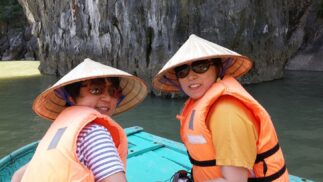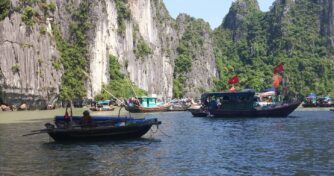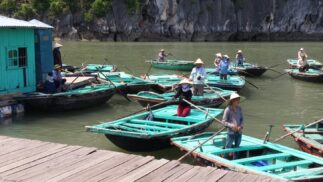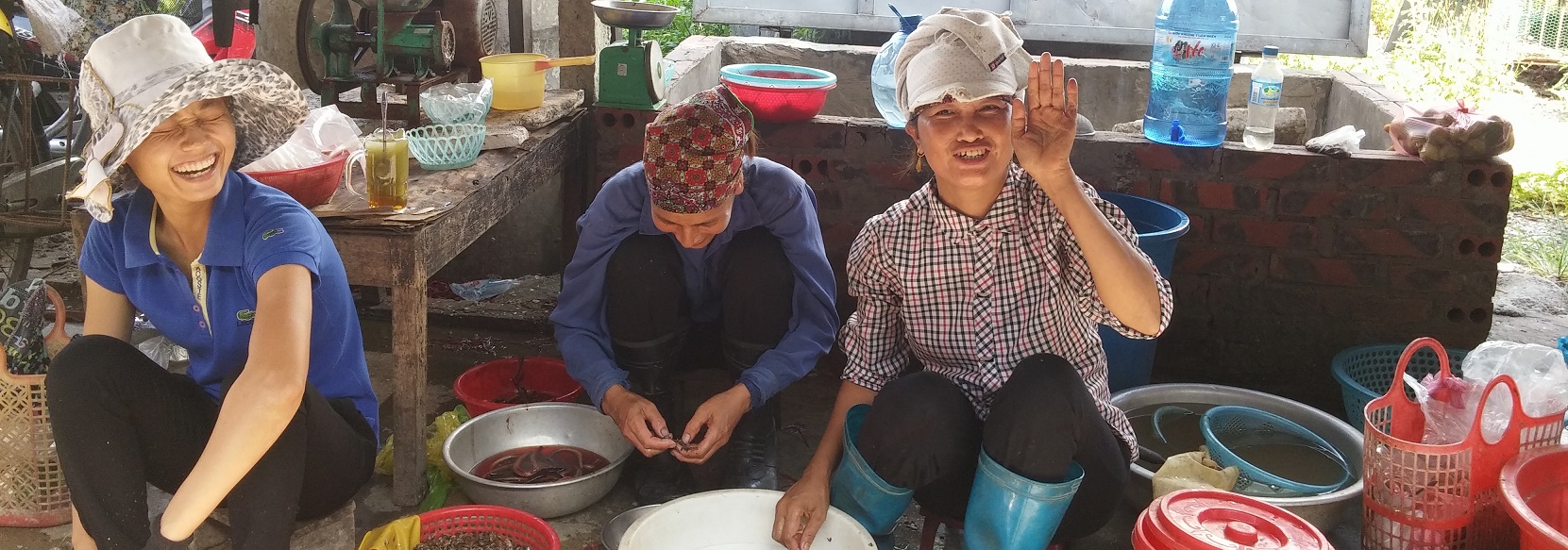When planning our trip to Vietnam, I really wanted to experience, if possible, rural life. We’ve been to several large Asian cities in different countries and they all share vibrant but chaotic environments. In my research about Ha Long Bay Vietnam, the beautiful UNESCO World Heritage site, a couple travelers described their amazing experiences at Yen Duc. It was exactly what I was hoping for to balance out Hanoi, the high octane 1,000 year old capital. Life here is very simple, rustic, colorful and full of tradition. And in this communist country, spiritual beliefs and religions, primarily Buddhism, are practiced openly.
Indochina Junk, a tour operator that I found to be the best fit for us (and the first tour company we have ever used), has a wonderful guide named Thuy (twee). She was born and raised in Yen Duc, is fearless, and knows everyone in this beautiful village including a number of neighbors who are happy to share pieces of their lives with nosey tourists. We stayed at Mr. San and Ms. Tam’s new homestay, one of the few in the village. They started this business now that their three adult children are gone and have families of their own. San and Tam don’t speak English, but between body language and Thuy’s insightful and continuous translating, we were able to communicate; they were very sweet and wonderful hosts.
Yen Duc is made up mostly of small, simple homes surrounded by large courtyards made of stone or brick walls. It was fascinating to see courtyards and streets covered with newly harvested drying rice. Many daily activities happen in the courtyard and is an extension of the home. Home cooking is of primary importance, and makes up a lot of time each day. At Tam and San’s in the morning shade we had a traditional breakfast in the courtyard; in the heat of the afternoon we lunched on many fresh vegetables on the living room floor; and after dark, we dined on the open front room floor. Afterward, Thuy showed us how to make two dishes including a dessert, while a couple of San’s friends came by to play Chinese Chess. As a sign of respect, shoes are never worn in the house, slippers are provided or you go barefoot (This is common throughout Asia. It is so prevalent that we do not wear shoes in our condo in Singapore or at anyone’s home).
We had a number of fascinating experiences in our action-packed stay. When we arrived around dinner time from Ha Long Bay, Thuy had us jump on bikes and go to the fishing pond to try our hand at catching fish using wicker baskets. The pond was shallow with deep mud and water plants. We had on waders up to our waists and I thought for sure the mud was going to suck the boots off my feet and knock me into the muddy water. I caught a few fish but not without the help of a local directing them to me. Afterward we threw them back. The next morning, we rode bikes to the fresh market which was filled with mostly women who seemed pretty interested in us. We met three girls who were preparing fresh river clams, tiny crabs and things I’ve never seen before. I bought the requisite hat that nearly every woman wears in Vietnam.
Thuy took us to visit a Bee Keeper and his wife at their home. We had some lovely tea, sampled honey, toured his beautiful gardens of exotic dragon fruit trees, and saw his many bee hives. Then we visited a broom maker and her husband. She tried to show Gene and me how to make a particular type of broom but we were pretty hopeless. You need strong, nimble hands, infinite patience and lots of practice. As time drew near, we didn’t want to leave.
For anyone wanting a rural travel experience, Yen Duc is a delightful journey off the beaten path in a very beautiful part of the world. Oh, and ask for Thuy to be your guide. We are still in touch with her.

HomeStay front and side

Enjoying a traditional breakfast

Tam chopping tea leaves

Tam and Thuy preparing dinner

Our fresh delicious lunch sitting on the livingroom floor
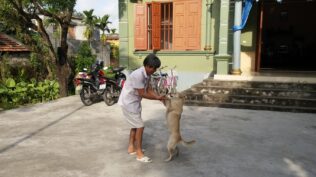
San playing with Milu

Tam and San, very sweet together

Mangosteens from the fresh market

Men playing Chinese Chess and board games after dinner

Enjoying dessert we made

Thuy taking us through Yen Duc on several adventures. Need to avoid rice drying in roads.

Riding to the fresh market

3 girls preparing river crabs, clams to sell at the market

Thuy demonstrating how to balance baskets

Supper on the front porch

Broom maker helping Gene learn about making brooms

Broom maker’s front room

Bee Keeper showing us his bees

Bee Keepers’ front room where we had tea and tried fresh honey

Bee Keeper’s front entrance, alter is typically placed here

Ducks, rice fields and rock formations in the village




